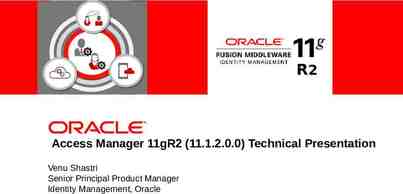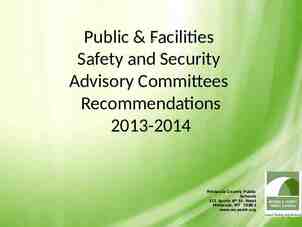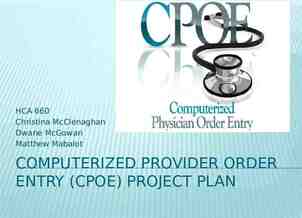AT&T Business Services Internet Telephony Conference
20 Slides884.00 KB

AT&T Business Services Internet Telephony Conference Enterprise Roundtable: State of the Industry February 6, 2003 Joe Aibinder Director, AT&T VoIP Business Services

VoIP Industry Background - Evolution The value of VoIP is evolving from basic cost savings to leveraging convergence to enhanced value-added applications. Arbitrage Int’lDomestic 1999 Convergence 2001 Emerging Services and Applications 2003 1999– The most frequent use of VoIP has been international settlements arbitrage – As settlements and PSTN rates decrease these advantages decline 2001 – True Convergence of bandwidth Voice and data are allocated dynamically on access and backbone facilities Added bandwidth becomes available due to convergence of voice and data 2003 – Emerging applications provide customers with competitive advantages 2 2 AT&T Proprietary 2

VoIP Evolution: Arbitrage Savings International International Transport Domestic Transport CO or PBX Traditional Network Interconnect settlements Arbitrage-VoIP Replacement U.S. Office IP Telephony CO or PBX International Office Local Termination Router/Gateway IP Transport IP Telephony Gateway 3 3 AT&T Proprietary 3

Voice Savings Opportunities 1. Switched Access Cost Reduction 3. Transport Cost Reduction 2.Switched Egress Cost Reduction How? Lower Converged Cost of VoIP How? Single Access Switched or Nodal Access Network How? Arbitrage On-Net Egress Egress 4. Operations Simplification How? Single Customer SPOC Single Network -Single NOC Convergence 4 4 AT&T Proprietary 4

Emerging Applications VoIP will be the key IP application that drives the innovation friendly IP architectures that stimulate the creativity of developers The core generation of new IP communications and collaborative applications will include: IM / UM / Presence E-Contact Centers, IP-based Call Centers Virtual Meetings / Collaboration (NetMeeting) Desktop Multimedia IP Centrex in a Box Multi-Point Videoconferencing, etc. But what’s the emerging killer application? 5 5 AT&T Proprietary 5

Voice Over IP Marketplace Drivers Emergence of Native IP Environments – IP Centrex, IP PBX, IP Phones, Soft Phones, Multimedia on the LAN – 3G Wireless, Broadband Networks Enterprises seeking to save money on intra-company telephone calls and faxes Companies want web-based call centers/web callback/ecommerce New IP Based Features and Services – Mobility – Unified Messaging, Multimedia Conferencing – Follow Me, Portals Technology Maturing with Open Standards for easier, faster innovation 6 Converging Local, LD and Data services AT&T Proprietary 6 6

VoIP Services Development Building Common Infrastructures and Technologies Enterprise Offers International Managed VoIP: EVPN, Local: IP Centrex/Virtual PBX Managed PBX Apps/E-Contact Next Gen. Network Global Clearinghouse New Hop-Off Core Network IP Tandem Class 4/5 Local Service Provider Broadband Offers PC Based Services Wireless Broadband Wholesalers 7 7 AT&T Proprietary 7

AT&T VoIP Offer Overview - Portfolio RoadMap For the Enterprise, AT&T’s VoIP Portfolio is based on providing a spectrum of services of increasing value from basic voice services to enhanced applications . VoIP Portfolio Stack Unified Msg. Instant Msg. Electronic Contact * Portals Enhanced Conferencing Value Applications Advanced Enterprise Services Mgd. Voice* Soft Phones Intelligent Routing IP PBX ACD (Switching and Routing) Broadband SOHO Managed Data and IP MIS Distribution Centers Frame Relay Headquarters (Basic Voice Services) ATM Branches Wireless Satellite Sites Connectivity Location *Available Today 8 IP Phones AT&T Proprietary IP SDN IP Centrex Key Systems On/Off Net* PBX International* Premises Equipment Services 8 8

Technology Overview - Advanced VoIP VoIP call flow involves packetizing voice at the Gateway and routing the call via the Gatekeeper. VoIP 201 OSS and Ops Ctr Softswitches/Gatekeepers provide call routing, call control and various management functions Softswitch/Gatekeeper 5 Ethernet Source MM PC VoIP is Packetized Voice Real Time Transmission of Voice as Data Packets vs. Analog streams IP packets, Frame packets, ATM packets IP packets can be sent over Public Internet, Carrier VPN over CBB, or Private Data Network Source IP Phone Router Ethernet Ethernet 6 Source PBX 1 3 Source Source Voice/Fax Gateway Router 4 IP Network 2 Gateways compress the 64K analog channel into an electronic data packet stream. Destination (PBX, Central Office, or LAN) 7 6 Destination Voice/Fax Gateway Router 8 9 Direction of call PSTN 9 9 AT&T Proprietary 9

Growth for IP Voice Services Industry analysts at IDC state, “IP Telephony service revenue will grow at an annual rate of 50 percent for the next five years, increasing from 3.5 billion in 2002 to 35 billion in 2007.” Source: IDC Worldwide Telecom Black Book, November 2002 10 10 AT&T Proprietary 10

VoIP Service Options: AT&T’s Voice over IP Services Portfolio Managed VPN Customers: Add voice to current VPN Network Managed Internet Services customers: Add voice to their Internet connection; Jan. 2001 Managed Router Services customers: Add voice to their Frame Relay services Managed Data Network Services Frame Relay Offer to 40 Countries; Sept. 2001 Added D-3 Speeds and extranet extensions to offers; Nov. 2001 Enterprise Office Enterprise Office or Hop-Off Public Switched Network PBX CO or PBX Domestic Transport US International Transport IP Transport Router Domestic Transport US Router Managed Frame Relay Can be US or Global 11 AT&T Proprietary 11 11

AT&T’s VoIP Portfolio Enhancements: Spring 2002 VON Announcement AT&T interworks its VoIP services, leveraging its Managed IP, FR and ATM platforms On–Net and Off-Net VoIP services extended to all AT&T’s Global VoIP Sites PBX Router MIS AT&T Managed IP PSTN PBX Router MRS & MDNS AT&T Frame / ATM Managed Internet Services (MIS) with VoIP IP Transport with enhanced QoS plus: - 768kbps to T-3 access speeds -Global On Net, with MRS and MDNS VoIP Sites -Hop-Off to PSTN anywhere in the world Managed Data Network Services and Managed Router Services (MDNS and MRS) with VoIP Global Frame Transport with QoS enhanced with -ATM transport option -Domestic access speeds up to T-3 - Hop-Off to PSTN anywhere in the world 12 12 AT&T Proprietary 12

So what is really happening in the market? IP telephony equipment vendors in pitched battle over the premises – Cisco started it: Traditional PBX vendors now heavily in the fray – Customers new risk, “don’t want to invest in obsolete PBX ” Customers want to minimize risk in migrating to new IP model – HQ ITS vs. Divisional ITS; ITS manager’s job is on the line – Object of trial: Define business case and prove in solution – ITS internal trials can be first experience – Remote/greenfield sites running internal traffic - safest starting point – International sites: best economics but support can be issue – Contact center traffic is mission critical and last to put at risk Carriers need to reach production scale for sustainability – Key: Demonstrate quality, provisioning and customer support – Pilot is opportunity to shine so plan for security, redundancy . 13 13 AT&T Proprietary 13

Current IP PBX Alternatives for Voice Services IP PBX vs. Legacy Hybrid Implementations I P PCs IP Phone Remote Location IP PBX Router Router P B X IP Network CBB Premises VoIP Gateway PC Phone Client L E G A C Y H Y B R I D 14 IP Phone IP Phone PC Phone Client 4E Network Router Local PSTN Existing Customer PBX IP Card Premises VoIP Gateway Network TDM Phones AT&T Proprietary Key IP PBX Issues: Connectivity to LEC Premises, LAN Support Proprietary PBX Implementations 14 Service Interworking with 14

Next Evolutionary Phase:Network Based IP Telephony Virtual IP PBX Configuration IP PBX AT&T Hosting Center TDM Phones SIP Phone Router Phone Cable or DSL I P P B X Remote Branch or Teleworker IP IP Network Adapter PC Phone Client VPN/Router or TA CBB Network Hop-Off Gateway (Optional) Premises VoIP Gateway Local PSTN 4E Network Network Key Virtual IP PBX focus: Application Consistency Premises, LAN Support 15 Local, Inbound Services 15 AT&T Proprietary 15

Current IP Centrex Standard Configuration Today Call Controller with IP Centrex TDM Phones SIP Phone I P C e n t r e x Router IP Phone Router IP Network Adapter PC Phone Client Remote Location CBB Network Hop-Off Gateway (Optional) Premises VoIP Gateway Local PSTN 4E Network Network Key IP Centrex Issues: Premises, LAN Support Local, Inbound Services 16 Redundancy, failure points 16 AT&T Proprietary 16

IVR / Call Center Integration Concept with SIP Based VoIP Services Callers 800 800 call PSTN Switched Access Call Call Call Legacy Call Center Center Center Centers VoIP SoftSwitch IVR Content signaling path signaling path VPN AT&T IP VPN VoIP Gateways I NTERNET Network VoIP Gateways VPN Switched Access PSTN 17 AT&T Proprietary Call Call New Gen Call Center Center Call Centers Center Call Call NGN Legacy Call Center Center Call Centers Center 17 17

VoIP - What does it take to make it work well? VoIP works well, provided you: Have a well-managed IP network with low packet loss, latency and latency jitter delivered through over-engineering and/or QoS Have gateways that introduce minimal latency packetization and jitter buffer delays 100 ms Address interoperability between Gateways and routers Softswitches/gatekeepers and gateways Softswitches/gatekeepers (multi-domain calls) PSTN Signaling and VoIP Signaling Have good CODECs in the gateways that delivers efficient encoding while maintaining good sound quality Understand how to tune the gateways automatic gain control settings, echo cancellation, etc. Understand how to hook the gateways up into COs, PBXs and international switches. 18 18 AT&T Proprietary 18

Voice Quality Monitoring & Rating 19 VoIP QoS Monitoring for Network Averages (Watchdog) – This internal tool watches the network paths between customer sites for quality. – Voice must be sampled more frequently than data to capture quality issues. – Based on “R” factor thresholds, auto-tickets are created for possible network reroutes around congestions. VoIP QoS Monitoring for Individual Customer Calls (NPR) – Call rating is presented on a secure web site for customer review. – NPR customer reports will be the basis for future VoIP SLAs AT&T’s VoIP Service DMOQs – Latency, Jitter, Packet Loss, Call Completion, Quality of – Blocking, Availability, Post dial delay, R-factor voice MOS – Time to restore and provision rating “R” factor (ITU G.107, May 2000) 90 R Best 4.34 – 4.5 – Uses the ITU “R” Factor VoIP Standard 100 80 R High 4.03 – – Rates calls based on latency, packet loss and 4.34 jitter according to the ITU G.107 & G.114 standard. 90 70 R Medium 3.60 – 80 4.03 60 R Low 3.10 – 19 70 3.60 19 AT&T Proprietary 50 R Poor 2.58 –

Critical Success Factors for the VoIP Services Model Comprehensive, Global, IP portfolio that includes premises support Security, Reliability and Redundancy are Critical Transparent, seamless IP services delivery with efficient interworking among networks and technologies IP and legacy data networks (FR,ATM) Legacy and IP Telephony Premises Systems IP and PSTN Networks IP technology and protocols migration (H.323, SIP, etc.) IP Applications (VoIP, IM, Video, UM, Conferencing etc.) Attractive economic incentives for migration to IP technologies Convergence of voice and data facilities with dynamic bandwidth Simplified network management and improved network ROI QoS and SLAs Establishing clear, manageable, migration path from the customer’s starting point to the innovative IP applications of the future 20 20 AT&T Proprietary 20






